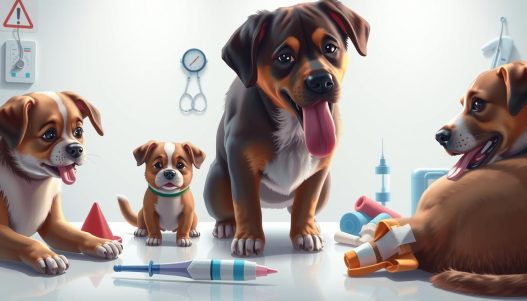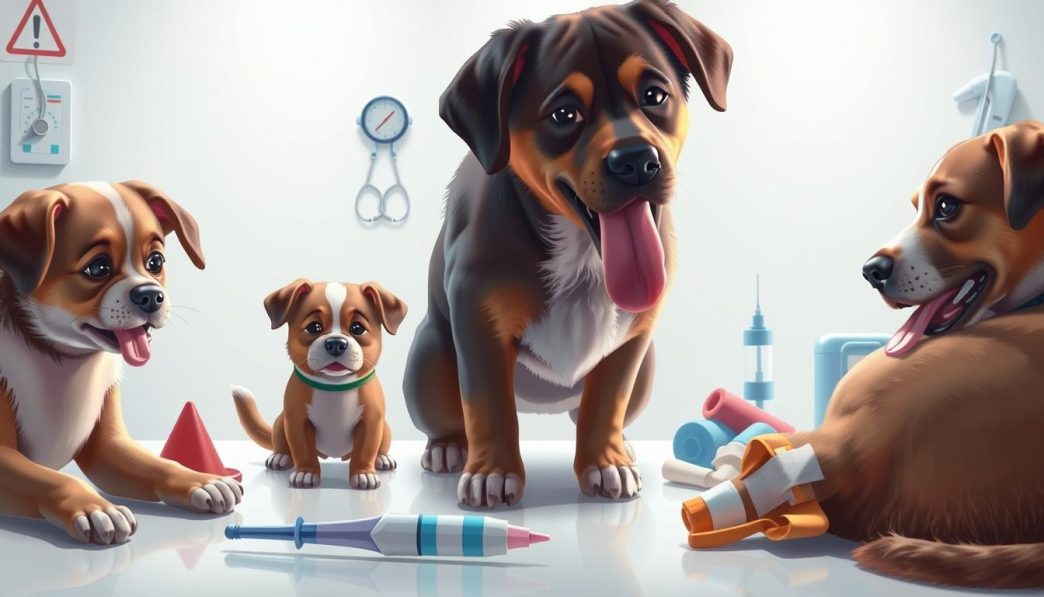As a responsible pet owner, it’s crucial to recognize the signs that indicate emergency vet care is needed. Understanding these critical signs can be the difference between life and death for your pet.
Being aware of pet emergency signs ensures your pet receives timely medical attention. Some situations require immediate action, and knowing what to look out for can help you respond quickly and effectively.
Key Takeaways
- Recognizing emergency signs can save your pet’s life.
- Immediate vet care is crucial in emergency situations.
- Understanding animal health indicators is vital.
- Timely medical attention can prevent serious complications.
- Being prepared can make a significant difference in pet emergencies.
Recognizing Life-Threatening Pet Emergencies
Life-threatening pet emergencies can arise suddenly, and being able to identify them quickly is crucial for saving a pet’s life. As a pet owner, it’s vital to be aware of the signs that indicate your pet needs immediate veterinary care.
The Importance of Quick Action
Quick action is essential in life-threatening pet emergencies. Delaying treatment can lead to severe consequences, including death. Knowing what to look for and acting swiftly can make a significant difference in the outcome for your pet. According to veterinary experts, “Prompt recognition and response to emergency situations are critical for improving survival rates and reducing the risk of long-term damage.”
General Emergency Signs for All Pets
While specific emergencies may present differently, there are general signs that pet owners should be aware of. These include difficulty breathing, severe injuries, sudden changes in behavior or appetite, and signs of extreme pain or distress. Being vigilant and recognizing these emergency signs early on can help ensure your pet receives the necessary care in a timely manner.
Some common emergency signs to watch out for include labored breathing, bleeding that won’t stop, severe vomiting or diarrhea, and sudden paralysis or inability to stand. If you observe any of these signs, it’s crucial to seek veterinary help immediately.
Digestive and Abdominal Emergency Signs
Recognizing the signs of digestive and abdominal emergencies is crucial for pet owners. Digestive issues can quickly become life-threatening if not addressed promptly.
Several key signs indicate that your pet may be experiencing a digestive or abdominal emergency. These include severe or persistent vomiting and diarrhea, bloating or a distended abdomen, and a complete loss of appetite or inability to swallow.
Severe or Persistent Vomiting and Diarrhea
Vomiting and diarrhea are common symptoms in pets, but when they become severe or persistent, they can lead to dehydration and other serious complications. Immediate veterinary care is necessary if your pet is unable to keep food or water down, or if there’s blood in their vomit or stool.
Bloating, Distended Abdomen, and GDV Risk
A bloated or distended abdomen can be a sign of a serious condition known as Gastric Dilatation-Volvulus (GDV), particularly in large breed dogs. GDV requires immediate veterinary attention as it can be life-threatening. Watch for restlessness, panting, and drooling in addition to a swollen abdomen.
Complete Loss of Appetite or Inability to Swallow
A sudden loss of appetite or difficulty swallowing can indicate a range of issues, from dental problems to gastrointestinal blockages. If your pet shows these signs, it’s crucial to seek veterinary care to determine the cause and appropriate treatment.
Some common signs that may indicate a digestive emergency include:
- Vomiting blood or diarrhea with blood
- Severe abdominal pain
- Failure to pass stool or gas
- Lack of appetite or refusal to eat
Respiratory Distress: When Your Pet Can’t Breathe Properly
Identifying the signs of respiratory issues in your pet can be the difference between life and death. Respiratory distress is a critical condition that requires immediate attention. Pets experiencing breathing difficulties may exhibit a range of symptoms, from labored breathing to life-threatening complications.

Labored, Rapid, or Open-Mouth Breathing
Labored, rapid, or open-mouth breathing in pets is often a sign of underlying respiratory issues. This can be caused by various factors, including asthma, allergies, or heart disease. If your pet is experiencing any of these symptoms, it’s essential to seek veterinary care promptly.
Choking, Gagging, and Airway Obstructions
Choking or gagging in pets can indicate an airway obstruction, which is a medical emergency. If your pet is unable to clear the obstruction, it can lead to asphyxiation. Immediate action is necessary to prevent serious harm or death.
Blue Gums or Tongue (Cyanosis)
Cyanosis, characterized by blue-tinged gums or tongue, is a critical sign that your pet is not receiving enough oxygen. This condition requires immediate veterinary attention, as it can be a sign of severe respiratory distress.
| Signs of Respiratory Distress | Description | Action Required |
|---|---|---|
| Labored Breathing | Difficulty breathing, often with increased effort | Seek veterinary care |
| Choking/Gagging | Obstruction in the airway | Immediate veterinary emergency |
| Cyanosis | Blue gums or tongue due to lack of oxygen | Immediate veterinary attention |
Neurological and Mobility Emergency Signs
Recognizing the signs of neurological and mobility emergencies is crucial for the well-being of your pet. These conditions can be alarming and require immediate veterinary care. Neurological emergencies involve the nervous system and can manifest in various ways, including seizures, paralysis, and disorientation.
Seizures, Convulsions, and Tremors
Seizures, convulsions, and tremors are indicative of neurological distress. Seizures can be caused by various factors, including epilepsy, toxin exposure, or metabolic disorders. If your pet experiences a seizure, remain calm and ensure their safety by removing any objects that could cause injury. Prompt veterinary attention is essential to diagnose and treat the underlying cause.
Sudden Paralysis, Weakness, or Inability to Stand
Sudden paralysis, weakness, or the inability to stand are serious mobility issues that require immediate attention. These symptoms can result from spinal cord injuries, neurological conditions, or other severe health issues. As one expert notes,
“Prompt action is crucial when dealing with sudden paralysis or weakness, as timely intervention can significantly impact the outcome.”
Disorientation, Head Tilting, and Loss of Balance
Disorientation, head tilting, and loss of balance are signs of neurological dysfunction. These symptoms can be associated with inner ear infections, neurological disorders, or toxin exposure. If your pet exhibits these signs, it’s vital to seek veterinary care to determine the cause and appropriate treatment.
Signs Your Pet Needs to See a Vet Immediately: Urinary and Reproductive Issues
Recognizing the signs of urinary and reproductive issues in pets is crucial for their health and well-being. These emergencies can be painful and potentially life-threatening, making prompt veterinary care essential.
Straining to Urinate or Defecate Without Success
When pets strain to urinate or defecate without success, it can be a sign of a serious underlying condition. This could be due to urinary tract infections, stones, or other obstructions. Immediate veterinary attention is necessary to diagnose and treat the cause.
Bloody Urine, Stool, or Abnormal Discharge
The presence of blood in the urine or stool, or abnormal discharge from the reproductive tract, can indicate a range of health issues, from infections to more severe conditions like cancer. Monitoring these signs and seeking veterinary care promptly is vital.
Pregnancy and Birth Complications
Pregnancy and birth complications can arise in pets, just as in humans. Signs of distress during pregnancy or labor, such as prolonged labor or signs of fetal distress, require immediate veterinary intervention to ensure the health of both the mother and the offspring.
| Symptom | Possible Cause | Action Required |
|---|---|---|
| Straining to Urinate | Urinary Tract Infection or Obstruction | Seek Immediate Veterinary Care |
| Bloody Urine or Stool | Infection, Injury, or Cancer | Consult a Veterinarian Promptly |
| Abnormal Discharge | Infection or Reproductive Issue | Get Veterinary Advice |
Poisoning and Toxic Ingestion Emergencies
Recognizing the signs of poisoning in pets is crucial for their immediate care and treatment. Pets are often exposed to toxic substances in their environment, and prompt action can save their lives.
Common Household Toxins and Their Symptoms
Many common household items can be poisonous to pets. Cleaning supplies, pesticides, and certain medications are among the top toxins. Symptoms can range from vomiting and diarrhea to seizures and lethargy, depending on the substance ingested.
Plant, Food, and Medication Poisoning
Certain plants like lilies and sago palms are toxic to pets. Foods such as chocolate, grapes, and onions can also be harmful. Medication poisoning occurs when pets ingest human medications, which can be highly toxic. Knowing what’s toxic can help prevent accidents.
What to Do If You Suspect Poisoning
If you suspect your pet has ingested something toxic, act quickly. Contact your veterinarian or a pet poison hotline immediately. Keep the substance or its packaging handy to provide information to the vet.
| Toxic Substance | Symptoms | Action |
|---|---|---|
| Chocolate | Vomiting, Diarrhea, Hyperactivity | Contact Vet, Provide Chocolate Details |
| Lily Plants | Vomiting, Lethargy, Lack of Appetite | Seek Immediate Veterinary Care |
| Human Medication | Varying Symptoms, Often Severe | Call Pet Poison Hotline, Provide Medication Name |
Trauma and Injury Emergencies
Recognizing the signs of trauma and injury in pets is vital for ensuring they receive the necessary medical attention in a timely manner. Pets can suffer from various types of trauma and injuries, ranging from minor to life-threatening conditions. It is crucial for pet owners to be aware of the emergency signs that require immediate veterinary care.
Severe Bleeding, Puncture Wounds, and Lacerations
Severe bleeding, puncture wounds, and lacerations are common trauma-related injuries in pets. Severe bleeding can lead to shock and death if not addressed promptly. Puncture wounds, often caused by sharp objects, can be deceiving as they may appear minor on the surface but can cause significant internal damage. Lacerations, or cuts, can also be prone to infection if not properly treated.
Suspected Broken Bones and Severe Limping
Broken bones and severe limping are indicators of potential trauma or injury. Pets may exhibit reluctance to move or put weight on a limb, signaling a possible fracture. Severe limping should not be ignored, as it can be a sign of a serious underlying condition that requires veterinary attention.
Burns, Heatstroke, and Hypothermia
Burns, heatstroke, and hypothermia are serious conditions that can result from various environmental exposures. Burns can occur from thermal sources, chemicals, or electrical sources. Heatstroke is a life-threatening condition that occurs when a pet’s body temperature regulation fails, often due to being left in a hot vehicle. Hypothermia, on the other hand, occurs when a pet’s body temperature drops too low, often due to prolonged exposure to cold.
| Condition | Signs | Initial Action |
|---|---|---|
| Severe Bleeding | Bleeding that doesn’t stop, pale gums | Apply pressure, seek immediate vet care |
| Puncture Wounds | Small wound, potential internal damage | Seek vet care immediately |
| Broken Bones | Limping, swelling, pain | Immobilize, seek vet care |
| Burns | Redness, blisters, charred skin | Cool with water (not ice), seek vet care |
Behavioral Changes That Signal Emergency
Pets display various behavioral changes when faced with a medical emergency, and being aware of these changes can save their lives. Behavioral changes can be indicative of an underlying condition that requires immediate veterinary care.
Extreme Lethargy, Collapse, or Unresponsiveness
Extreme lethargy or unresponsiveness in pets is a serious sign that something is wrong. If your pet is unusually lethargic, has collapsed, or is unresponsive, it’s crucial to seek veterinary help immediately. These signs can indicate severe illness or injury, such as poisoning, heart conditions, or severe infections.
Sudden Aggression, Disorientation, or Vocalization
Sudden aggression or disorientation in pets can be a sign of pain, neurological issues, or other serious conditions. If your pet becomes aggressive, disoriented, or starts vocalizing unusually, it may be experiencing a medical emergency. Conditions such as encephalitis, toxic ingestion, or head trauma can cause these behavioral changes.
Signs of Severe Pain or Distress
Pets in severe pain or distress often exhibit specific behaviors, such as whining, panting, restlessness, or changes in posture. Recognizing these signs early can help in providing timely care. Severe pain can be due to various reasons, including injuries, internal conditions, or post-operative complications.
Understanding these behavioral changes can help pet owners take prompt action. The table below summarizes key emergency signs and possible causes.
| Behavioral Change | Possible Causes |
|---|---|
| Extreme Lethargy | Severe illness, infection, poisoning |
| Sudden Aggression | Pain, neurological issues, toxic ingestion |
| Signs of Severe Pain | Injuries, internal conditions, post-operative complications |
Being vigilant about these changes and seeking veterinary care promptly can significantly improve your pet’s chances of recovery.
Breed-Specific Emergency Situations
Breed characteristics can significantly influence the type of veterinary emergencies a pet may face. Understanding these breed-specific risks is essential for pet owners to provide timely and appropriate care.
Small Breed Emergencies
Small breeds are prone to specific emergencies such as hypoglycemia and tracheal collapse. Hypoglycemia, or low blood sugar, can occur due to their high metabolism and small liver size. Tracheal collapse is another serious condition where the airway collapses, leading to severe coughing and breathing difficulties.
Large Breed Critical Signs
Large breeds have their unique set of emergency signs, notably bloat and joint issues. Bloat, or gastric dilatation-volvulus (GDV), is a life-threatening condition where the stomach fills with gas and twists. Joint issues, including hip dysplasia, can lead to severe pain and mobility problems.
Brachycephalic Breed Urgent Care Needs
Brachycephalic breeds, with their short noses and flat faces, are susceptible to breathing distress. Their compact airways can lead to obstructed breathing, especially in hot or stressful conditions. Immediate veterinary care is crucial if these breeds show signs of respiratory distress.

What to Do While Heading to the Emergency Vet
In the event of a pet emergency, every minute counts, and knowing how to respond can make a difference. While rushing to the emergency vet, you can take several crucial steps to ensure your pet receives the best possible care.
Essential First Aid for Common Pet Emergencies
Administering first aid can be lifesaving. For bleeding, apply gentle pressure with a clean cloth. For poisoning, contact the ASPCA’s Animal Poison Control Center or your vet for advice. Knowing these basics can help stabilize your pet.
Safely Transporting an Injured or Sick Pet
When transporting an injured pet, it’s crucial to minimize movement to prevent further injury. Use a blanket or towel to support their body, and drive carefully to avoid sudden stops.
Information to Gather for Your Veterinarian
Gathering relevant information before the vet visit can be helpful. This includes your pet’s medical history, the symptoms you’re observing, and any recent changes in behavior or appetite. Having this information ready can aid in a quicker diagnosis.
By being prepared and knowing what to do during the trip to the emergency vet, you can significantly impact your pet’s recovery and well-being.
Conclusion: Being Prepared Saves Lives
Being prepared for pet emergencies can be the difference between life and death. By understanding the key signs and symptoms outlined in this article, you can ensure your pet receives timely medical attention when they need it most.
Pet emergency preparedness is crucial for every pet owner. Having a plan in place, knowing what to look for, and being aware of the nearest emergency veterinary clinic can save precious time and potentially save your pet’s life.
By being proactive and prepared, you can reduce the risk of your pet’s condition worsening and ensure they receive the best possible care. Take the first step today by creating a pet emergency kit, having a list of emergency contact numbers handy, and staying informed about potential hazards.
Preparedness is key to keeping your pet safe. Stay vigilant, and you’ll be better equipped to handle any unexpected situations that may arise.






